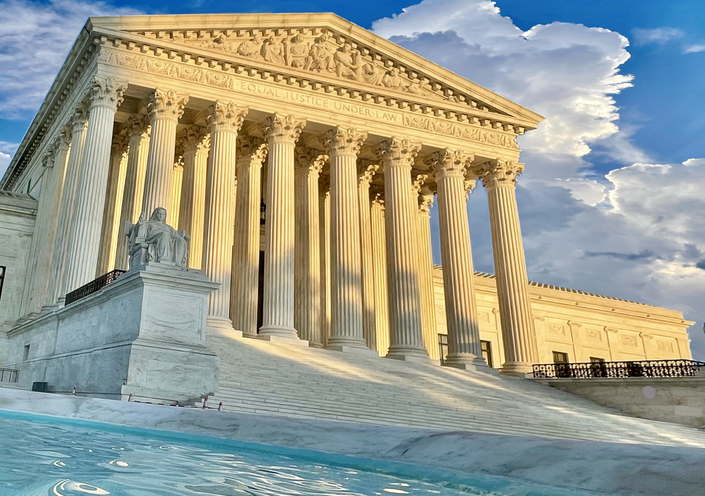
In West Virginia v. EPA, the Supreme Court cements the major questions doctrine and strengthens the separation of powers.
There are aspects of the U.S. Supreme Court’s decision in West Virginia v. EPA that will be studied and debated by scholars—and, indeed, by judges, lawmakers, and executive branch officials—for years to come. But there is little doubt that the decision will be consequential for the administrative state and the interbranch relationships in the U.S. constitutional system grounded in separation of powers.
With Chief Justice John Roberts writing the majority opinion for himself and five other Justices, the Court held that Congress did not grant the Environmental Protection Agency (EPA) authority in the Clean Air Act to establish emissions caps based on what the agency called a “generation-shifting” approach to moving electricity production from higher-emitting to lower-emitting sources.
The majority relied on what is known as the “major questions doctrine”—which holds there are certain “extraordinary cases” that require a “clear congressional authorization” for the agency to exercise certain powers that it claims. In reviewing earlier cases in which the major questions doctrine rationale was invoked, at times more or less explicitly, the Court pointed out that these prior decisions typically involved major issues of political or economic significance.
Here I offer some takeaways from the West Virginia case, albeit with the reservation that I likely will have more to say in the future and in a more exhaustive way.
First, West Virginia follows a recent trend in which the Court does not even mention Chevron deference despite the case at hand involving an agency’s interpretation of its statutory authority, which is what Chevron v. NRDC was all about. Chevron deference requires a reviewing court to determine whether the statutory provisions at issue are ambiguous or contain gaps for the agency to fill and, if so, defer to the agency’s interpretation.
In a forthcoming law review article examining the Court’s recent NFIB v. OSHA decision, I and my co-author, Andrew Magloughlin, have predicted that Chevron deference will play a diminished role going forward in the review of administrative agency actions. Without even referring to the familiar Chevron inquiry, the Court in West Virginia relied entirely on the major questions doctrine by determining that the text and structure of the Clean Air Act did not clearly authorize EPA’s sweeping regulations.
The failure to invoke Chevron deference in a string of recent cases—including West Virginia, American Hospital Association v. Becerra, NFIB v. OSHA, and Alabama Realtors Association v. HHS—is consequential because it indicates the Court’s growing unwillingness to defer to agency decisions. The Court’s increasingly frequent invocation of the major questions doctrine coupled with a more exacting application of the traditional tools of statutory interpretation—as in American Hospital Association v. Becerra—indicates that the Court is less likely than in the past to find gaps in statutes for agencies to fill. This shrinking of Chevron’s domain means, overall, agencies’ unfettered discretion to devise policy will be curtailed.
Second, consistent with another prediction in my forthcoming law review article, West Virginia further cements the major questions doctrine in the Court’s jurisprudence as a standalone canon of interpretation. The Court has now applied the major questions doctrine to review significant agency actions three times in less than two years without reference to Chevron deference. This application contrasts with earlier Supreme Court decisions that applied the major questions doctrine in conjunction with a Chevron doctrine analysis or applied it as an exception to the deference doctrine.
This is a welcome development because, as Justice Neil Gorsuch explains in his West Virginia concurrence, the major questions doctrine’s clear statement rule respects the Vesting Clause in Article I of the U.S. Constitution, which reads: “All legislative Powers herein granted shall be vested in a Congress of the United States.”
Given that the Constitution assigns all of the legislative power to Congress, it is proper for the Court to preserve the separation of powers by requiring a clear statement from Congress before executive branch officials exercise rulemaking powers—which constitute lawmaking—in extraordinary cases of major economic or political significance.
This may have the salutary effect of provoking Congress to adopt laws with more specific directions. But a shift in power will constrain the broad policymaking discretion of unelected executive officials that, in the U.S. tripartite system of separated powers, should properly be the domain of the people’s elected representatives.
Third, dicta from the majority opinion may indicate that, for now, the Court does not intend to revitalize or adopt a more stringent application of the nondelegation doctrine. With respect to the EPA plan that the Court invalidated, Chief Justice Roberts wrote: “A decision of such magnitude and consequence rests with Congress itself, or an agency acting pursuant to a clear delegation from that representative body.”
This statement could be read to infer that a clear statement by Congress that an agency is authorized to adopt a regulatory program raises no nondelegation doctrine issue, even if the authorization lacks any intelligible implementing directions. An example would be if Congress enacted a statute stating that “EPA is authorized to devise and implement rules determining the appropriate energy source composition of the nationwide electrical grid.” But I am reluctant to bury revitalization of the nondelegation doctrine based on this one cryptic sentence in the majority’s opinion.
Finally, West Virginia could have a significant impact on the decades-long net neutrality controversy involving Chevron which I previously addressed in The Regulatory Review in articles from 2019 and 2018. Both previous essays explain that when Federal Communications Commission rules adopting or repealing net neutrality mandates have been subject to judicial review, they have been affirmed primarily based on applying Chevron deference. In other words, regardless of which way the net neutrality regulatory ball bounced—pro or con—Chevron was dispositive in affirming the agency’s interpretation of its statutory authority.
Interestingly, the West Virginia majority opinion, without needing to do so, quoted then-Judge Kavanaugh’s dissent from denial of en banc review in United States Telecom Association v. FCC to the effect that the major questions doctrine presumes that “Congress intends to make major policy decisions itself, not leave those decisions to agencies.”
In U.S. Telecom, Judge Kavanaugh characterized the FCC’s net neutrality regulations as having a staggering financial impact and transforming the internet fundamentally, thereby arguing that the regulations’ lawfulness clearly constituted a major question. In NCTA v. Brand X Internet Services, the Supreme Court affirmed in a 5-4 split decision the FCC’s discretion to decide whether to impose net neutrality regulation on internet service providers based on the Court’s determination that the relevant statutory provisions are ambiguous. But given that a majority of the Court increasingly invokes the major questions doctrine and ignores Chevron, it is not difficult to imagine that now-Justice Kavanaugh’s position in his U.S. Telecom dissent might prevail if an FCC order imposing net neutrality regulation again reaches the Supreme Court.
If the courts were to apply the major questions doctrine to the long-running, bouncing-ball saga of the FCC’s authority to impose net neutrality regulation on internet service providers, this would constitute a good example of the salutary effect of further embedding the major questions doctrine in constitutional jurisprudence. A decision regarding the appropriate regulatory framework for internet service providers—in my view, a matter of sufficient importance to the nation’s social and economic well-being to be denominated a major question—would be removed from the ambit of unelected agency officials’ broad policymaking discretion.
In that instance, as in so many others involving major agency rules, including EPA’s adoption of the far-reaching Clean Power Plan at issue in West Virginia, it would then be up to Congress to decide whether to enact laws that delegate authority with enough specificity to guide agency officials in implementing them. In that event, consistent with the Framers’ intent in assigning Congress the lawmaking power, the people’s representatives will be accountable for their actions—or their inactions—at the ballot box and the Constitution’s separation of powers would be preserved.
This essay is part of a ten-part series entitled The Supreme Court’s 2021-2022 Regulatory Term.




